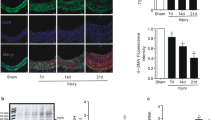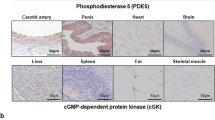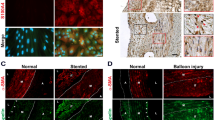Abstract
Coronary restenosis, a major complication of percutaneous balloon angioplasty, results from neointimal proliferation of vascular smooth muscle cells (VSMCs). The sarco/endoplasmic reticulum calcium ATPase 2a isoform (SERCA2a), specific to contractile VSMCs, has been reported previously to be involved in the control of the Ca2+-signaling pathways governing proliferation and migration. Moreover, SERCA2a gene transfer was reported to inhibit in vitro VSMC proliferation and to prevent neointimal thickening in a rat carotid injury model. The aim of this study was to evaluate the potential therapeutic interest of SERCA2a gene transfer for prevention of in-stent restenosis using a ex vivo model of human left internal mammary artery (hIMA) intimal thickening. Left hIMAs, obtained at the time of aorto-coronary bypass surgeries, were subjected to balloon dilatation followed by infection for 30 min with adenoviruses encoding either human SERCA2 and green fluorescence protein (GFP) or control gene (β-galactosidase, β-gal) and GFP. Proliferation of subendothelial VSMCs and neointimal thickening were observed in balloon-injured hIMA maintained 14 days in organ culture under constant pressure and perfusion. SERCA2a gene transfer prevented vascular remodeling and significantly (P<0.01, n=5) reduced neointimal thickening in injured arteries (intima/media ratio was 0.07±0.01 vs 0.40±0.03 in β-gal-infected arteries). These findings could have potential implications for treatment of pathological in-stent restenosis.
This is a preview of subscription content, access via your institution
Access options
Subscribe to this journal
Receive 12 print issues and online access
$259.00 per year
only $21.58 per issue
Buy this article
- Purchase on Springer Link
- Instant access to full article PDF
Prices may be subject to local taxes which are calculated during checkout







Similar content being viewed by others
References
Luscher TF, Steffel J, Eberli FR, Joner M, Nakazawa G, Tanner FC et al. Drug-eluting stent and coronary thrombosis: biological mechanisms and clinical implications. Circulation 2007; 115: 1051–1058.
Fukuda D, Sata M, Tanaka K, Nagai R . Potent inhibitory effect of sirolimus on circulating vascular progenitor cells. Circulation 2005; 111: 926–931.
Ueda M, Becker AE, Naruko T, Kojima A . Smooth muscle cell de-differentiation is a fundamental change preceding wound healing after percutaneous transluminal coronary angioplasty in humans. Coron Artery Dis 1995; 6: 71–81.
Nakagawa M, Naruko T, Ikura Y, Komatsu R, Iwasa Y, Kitabayashi C et al. A decline in platelet activation and inflammatory cell infiltration is associated with the phenotypic redifferentiation of neointimal smooth muscle cells after bare-metal stent implantation in acute coronary syndrome. J Atheroscler Thromb 2010; 17: 675–687.
Bobe R, Hadri L, Lopez JJ, Sassi Y, Atassi F, Karakikes I et al. SERCA2a controls the mode of agonist-induced intracellular Ca2+ signal, transcription factor NFAT and proliferation in human vascular smooth muscle cells. J Mol Cell Cardiol 2011; 50: 621–633.
Rekhter MD, Simari RD, Work CW, Nabel GJ, Nabel EG, Gordon D . Gene transfer into normal and atherosclerotic human blood vessels. Circ Res 1998; 82: 1243–1252.
Lipskaia L, del Monte F, Capiod T, Yacoubi S, Hadri L, Hours M et al. Sarco/endoplasmic reticulum Ca2+-ATPase gene transfer reduces vascular smooth muscle cell proliferation and neointima formation in the rat. Circ Res 2005; 97: 488–495.
Lipskaia L, Pourci ML, Delomenie C, Combettes L, Goudouneche D, Paul JL et al. Phosphatidylinositol 3-kinase and calcium-activated transcription pathways are required for VLDL-induced smooth muscle cell proliferation. Circ Res 2003; 92: 1115–1122.
Gueguen M, Keuylian Z, Mateo V, Mougenot N, Lompre AM, Michel JB et al. Implication of adenylyl cyclase 8 in pathological smooth muscle cell migration occurring in rat and human vascular remodelling. J Pathol 2010; 221: 331–342.
Gollasch M, Haase H, Ried C, Lindschau C, Morano I, Luft FC et al. L-type calcium channel expression depends on the differentiated state of vascular smooth muscle cells. Faseb J 1998; 12: 593–601.
Quignard JF, Harricane MC, Menard C, Lory P, Nargeot J, Capron L et al. Transient down-regulation of L-type Ca(2+) channel and dystrophin expression after balloon injury in rat aortic cells. Cardiovasc Res 2001; 49: 177–188.
Liu Z, Zhang C, Dronadula N, Li Q, Rao GN . Blockade of nuclear factor of activated T cells activation signaling suppresses balloon injury-induced neointima formation in a rat carotid artery model. J Biol Chem 2005; 280: 14700–14708.
Yu H, Sliedregt-Bol K, Overkleeft H, van der Marel GA, van Berkel TJ, Biessen EA . Therapeutic potential of a synthetic peptide inhibitor of nuclear factor of activated T cells as antirestenotic agent. Arterioscler Thromb Vasc Biol 2006; 26: 1531–1537.
Sedighiani F, Nikol S . Gene therapy in vascular disease. Surgeon 2011; 9: 326–335.
Van Assche T, Huygelen V, Crabtree MJ . Targeting vascular redox biology through antioxidant gene delivery: a historical view and current perspectives. Recent Pat Cardiovasc Drug Discov 2011; 6: 89–102.
Chen SH, Zhaori G . Potential clinical applications of siRNA technique: benefits and limitations. Eur J Clin Invest 2011; 41: 221–232.
Holt CM, Francis SE, Rogers S, Gadsdon PA, Taylor T, Clelland C et al. Intimal proliferation in an organ culture of human internal mammary artery. Cardiovasc Res 1992; 26: 1189–1194.
Swanson N, Javed Q, Hogrefe K, Gershlick A . Human internal mammary artery organ culture model of coronary stenting: a novel investigation of smooth muscle cell response to drug-eluting stents. Clin Sci (Lond) 2002; 103: 347–353.
Guerin P, Sauzeau V, Rolli-Derkinderen M, Al Habbash O, Scalbert E, Crochet D et al. Stent implantation activates RhoA in human arteries: inhibitory effect of rapamycin. J Vasc Res 2005; 42: 21–28.
Schwartz SM, deBlois D, O'Brien ER . The intima. Soil for atherosclerosis and restenosis. Circ Res 1995; 77: 445–465.
Stary HC, Blankenhorn DH, Chandler AB, Glagov S, Insull W, Richardson M et al. A definition of the intima of human arteries and of its atherosclerosis-prone regions. A report from the Committee on Vascular Lesions of the Council on Arteriosclerosis, American Heart Association. Arterioscler Thromb 1992; 12: 120–134.
Owens GK, Kumar MS, Wamhoff BR . Molecular regulation of vascular smooth muscle cell differentiation in development and disease. Physiol Rev 2004; 84: 767–801.
Kawase Y, Hajjar RJ . The cardiac sarcoplasmic/endoplasmic reticulum calcium ATPase: a potent target for cardiovascular diseases. Nat Clin Pract 2008; 5: 554–565.
Lipskaia L, Chemaly ER, Hadri L, Lompre AM, Hajjar RJ . Sarcoplasmic reticulum Ca(2+) ATPase as a therapeutic target for heart failure. Expert Opin Biol Ther 2010; 10: 29–41.
Lipskaia L, Hulot JS, Lompre AM . Role of sarco/endoplasmic reticulum calcium content and calcium ATPase activity in the control of cell growth and proliferation. Pflugers Arch 2009; 457: 673–685.
Tilemann L, Ishikawa K, Weber T, Hajjar RJ . Gene therapy for heart failure. Circ Res 2012; 110: 777–793.
Kho C, Lee A, Jeong D, Oh JG, Chaanine AH, Kizana E et al. SUMO1-dependent modulation of SERCA2a in heart failure. Nature 2011; 477: 601–605.
Sisto T, Isola J . Incidence of atherosclerosis in the internal mammary artery. Ann Thorac Surg 1989; 47: 884–886.
Guerin P, Rondeau F, Grimandi G, Heymann MF, Heymann D, Pillet P et al. Neointimal hyperplasia after stenting in a human mammary artery organ culture. J Vasc Res 2004; 41: 46–53.
Hlawaty H, Jacob MP, Louedec L, Letourneur D, Brink C, Michel JB et al. Leukotriene receptor antagonism and the prevention of extracellular matrix degradation during atherosclerosis and in-stent stenosis. Arterioscler Thromb Vasc Biol 2009; 29: 518–524.
Morimoto S, Mizuno Y, Hiramitsu S, Yamada K, Kubo N, Nomura M et al. Restenosis after percutaneous transluminal coronary angioplasty—a histopathological study using autopsied hearts. Japn Circ J 1990; 54: 43–56.
Aikawa M, Sakomura Y, Ueda M, Kimura K, Manabe I, Ishiwata S et al. Redifferentiation of smooth muscle cells after coronary angioplasty determined via myosin heavy chain expression. Circulation 1997; 96: 82–90.
Cable DG, Caccitolo JA, Caplice N, O'Brien T, Simari RD, Daly RC et al. The role of gene therapy for intimal hyperplasia of bypass grafts. Circulation 1999; 100: II392–II396.
Hadri L, Bobe R, Kawase Y, Ladage D, Ishikawa K, Atassi F et al. SERCA2a gene transfer enhances eNOS expression and activity in endothelial cells. Mol Ther 2010; 18: 1284–1292.
Han CI, Campbell GR, Campbell JH . Circulating bone marrow cells can contribute to neointimal formation. J Vasc Res 2001; 38: 113–119.
Sata M, Saiura A, Kunisato A, Tojo A, Okada S, Tokuhisa T et al. Hematopoietic stem cells differentiate into vascular cells that participate in the pathogenesis of atherosclerosis. Nat Med 2002; 8: 403–409.
Tanaka K, Sata M, Hirata Y, Nagai R . Diverse contribution of bone marrow cells to neointimal hyperplasia after mechanical vascular injuries. Circ Res 2003; 93: 783–790.
Zalewski A, Shi Y, Johnson AG . Diverse origin of intimal cells: smooth muscle cells, myofibroblasts, fibroblasts, and beyond? Circ Res 2002; 91: 652–655.
Frid MG, Aldashev AA, Dempsey EC, Stenmark KR . Smooth muscle cells isolated from discrete compartments of the mature vascular media exhibit unique phenotypes and distinct growth capabilities. Circ Res 1997; 81: 940–952.
Guerin P, Goueffic Y, Heymann MF, Pillet P, Al Habash O, Crochet D et al. Direct stenting limits sirolimus-eluting stent edge neointimal thickening. J Vasc Surg 2007; 46: 354–359.
Malik N, Francis SE, Holt CM, Gunn J, Thomas GL, Shepherd L et al. Apoptosis and cell proliferation after porcine coronary angioplasty. Circulation 1998; 98: 1657–1665.
Durand E, Mallat Z, Addad F, Vilde F, Desnos M, Guerot C et al. Time courses of apoptosis and cell proliferation and their relationship to arterial remodeling and restenosis after angioplasty in an atherosclerotic rabbit model. J Am Coll Cardiol 2002; 39: 1680–1685.
He H, Giordano FJ, Hilal-Dandan R, Choi DJ, Rockman HA, McDonough PM et al. Overexpression of the rat sarcoplasmic reticulum Ca2+ ATPase gene in the heart of transgenic mice accelerates calcium transients and cardiac relaxation. J Clin Invest 1997; 100: 380–389.
del Monte F, Williams E, Lebeche D, Schmidt U, Rosenzweig A, Gwathmey JK et al. Improvement in survival and cardiac metabolism after gene transfer of sarcoplasmic reticulum Ca(2+)-ATPase in a rat model of heart failure. Circulation 2001; 104: 1424–1429.
Byrne MJ, Power JM, Preovolos A, Mariani JA, Hajjar RJ, Kaye DM . Recirculating cardiac delivery of AAV2/1SERCA2a improves myocardial function in an experimental model of heart failure in large animals. Gene Therapy 2008; 15: 1550–1557.
Kawase Y, Ly HQ, Prunier F, Lebeche D, Shi Y, Jin H et al. Reversal of cardiac dysfunction after long-term expression of SERCA2a by gene transfer in a pre-clinical model of heart failure. J Am Coll Cardiol 2008; 51: 1112–1119.
Hajjar RJ, Zsebo K, Deckelbaum L, Thompson C, Rudy J, Yaroshinsky A et al. Design of a phase 1/2 trial of intracoronary administration of AAV1/SERCA2a in patients with heart failure. J Card Fail 2008; 14: 355–367.
Jaski BE, Jessup ML, Mancini DM, Cappola TP, Pauly DF, Greenberg B et al. Calcium upregulation by percutaneous administration of gene therapy in cardiac disease (CUPID Trial), a first-in-human phase 1/2 clinical trial. J Card Fail 2009; 15: 171–181.
Jessup M, Greenberg B, Mancini D, Cappola T, Pauly DF, Jaski B et al. Calcium Upregulation by Percutaneous Administration of Gene Therapy in Cardiac Disease (CUPID): a phase 2 trial of intracoronary gene therapy of sarcoplasmic reticulum Ca2+-ATPase in patients with advanced heart failure. Circulation 124: 304–313.
Eggermont JA, Wuytack F, Verbist J, Casteels R . Expression of endoplasmic-reticulum Ca2(+)-pump isoforms and of phospholamban in pig smooth-muscle tissues. Biochem J 1990; 271: 649–653.
Marty I, Robert M, Villaz M, De Jongh K, Lai Y, Catterall WA et al. Biochemical evidence for a complex involving dihydropyridine receptor and ryanodine receptor in triad junctions of skeletal muscle. Proc Natl Acad Sci USA 1994; 91: 2270–2274.
del Monte F, Harding SE, Schmidt U, Matsui T, Kang ZB, Dec GW et al. Restoration of contractile function in isolated cardiomyocytes from failing human hearts by gene transfer of SERCA2a. Circulation 1999; 100: 2308–2311.
Aramburu J, Garcia-Cozar F, Raghavan A, Okamura H, Rao A, Hogan PG . Selective inhibition of NFAT activation by a peptide spanning the calcineurin targeting site of NFAT. Mol Cell 1998; 1: 627–637.
Bardy N, Karillon GJ, Merval R, Samuel JL, Tedgui A . Differential effects of pressure and flow on DNA and protein synthesis and on fibronectin expression by arteries in a novel organ culture system. Circ Res 1995; 77: 684–694.
Lehoux S, Esposito B, Merval R, Tedgui A . Differential regulation of vascular focal adhesion kinase by steady stretch and pulsatility. Circulation 2005; 111: 643–649.
Acknowledgements
This work was supported by AHA SDG 0930116N (LL), by NIH (1K01HL103176) (LH), by Leducq Foundation through the Caerus network (05 CVD 03 to AML and RJH), by NIH R01 HL078691, HL057263, HL071763, HL080498 and HL083156 (RJH). We thank Dr A Tedgui (Paris Cardiovascular Research Center, HEGP, Paris, France) for helpful discussion; Drs S Kraner and CM Norris (Sanders-Brown Center on Aging, Lexington, KY, USA) for providing Ad-VIVIT, and Dr F Wuytack (University of Leuven, Belgium) for the anti-SERCA2a and anti-SERCA2b antibodies.
Author information
Authors and Affiliations
Corresponding author
Ethics declarations
Competing interests
The authors declare no conflict of interest.
Additional information
Supplementary Information accompanies the paper on Gene Therapy website
Rights and permissions
About this article
Cite this article
Lipskaia, L., Hadri, L., Le Prince, P. et al. SERCA2a gene transfer prevents intimal proliferation in an organ culture of human internal mammary artery. Gene Ther 20, 396–406 (2013). https://doi.org/10.1038/gt.2012.50
Received:
Revised:
Accepted:
Published:
Issue Date:
DOI: https://doi.org/10.1038/gt.2012.50



